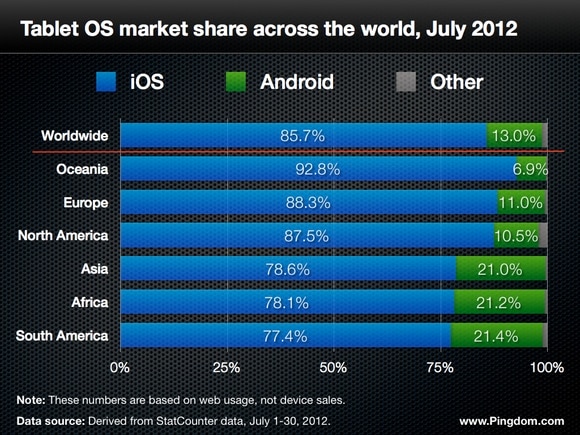
Apple has been dominating the tablet market ever since the company released the iPad, so calling the current situation a tablet war might be a bit overly dramatic. But things are heating up. The number of Android-based tablets is growing, and now even Google itself has joined the fray with the Nexus 7.
What is the current standing in this “tablet war,” and how does it differ across the world? Luckily, we can get an idea by using data from StatCounter. Their data is based on web usage (visitor stats from 3+ million websites), so it will represent the tablets actively used to surf the web.
As you’ll see, it basically comes down to the collective might of all Android tablet makers versus Apple’s iPad. Microsoft’s entry into the tablet market with Windows 8 isn’t here yet, and it remains to be seen if it will make an impact or not. Blackberry OS and webOS have disappearingly small market shares, and don’t seem to be a threat to anyone at the moment.
So, without further ado, here is the current lay of the tablet land…
Note that these OS numbers are only for tablets, not smartphones or other small-screen devices.
The iPad clearly still dominates across the board, in all parts of the world. The only difference is by how much.
Another way to look at these numbers is that for every Android tablet in use today in the world, there are 6.6 iPads.
Android has gained a bit, but not much
Comparing these results with the numbers from a similar survey we did back in November last year, Android has gained a bit of market share at the expense of the iPad, but not much.
Since last November, Apple’s iOS has gone from 87.9% to 85.7%, Android from 10.9% to 13.0%. These are relative numbers, of course. The absolute number of tablets out there is growing by leaps and bounds, so both Android and iOS are gaining users.
A few notes
- There are countries where the iPad has over 90% of the market. These include the United Kingdom (93.1%), Australia (93.2%), Ireland (90.2%), New Zealand (90.6%), Sweden (91.2%), Norway (92.7%), Denmark (95.0%), Iceland (93.6%), Switzerland (91.7%).
- Since it would seem that the iPad is doing very well in slightly more affluent countries, we had to check Monaco. And yes, iOS has 96.1% of the tablet market there.
- In the United States, iOS has 88.4% of the tablet market, Android has 10.3%, webOS has 0.8% and Blackberry OS has 0.4%.
- Worldwide tablet market share for Blackberry OS is 0.97%. The standout country here is RIM’s home market, Canada, where Blackberry OS has an 8.5% market share.
- Worldwide tablet market share for webOS is 0.32%.
- One could perhaps expect that with South Korea being the home market of Samsung and LG, Android-based tablets would have a favored position. That doesn’t seem to be the case though, with iOS at 81.5% and Android at 18.5%.
- Places where Android is doing relatively well against iOS include Thailand (iOS 76.5%, Android 23.5%), Taiwan (iOS 79.2%, Android 20.8%), Saudi Arabia (iOS 75.3%, Android 24.3%), Brazil (iOS 79.8%, Android 20.2%), Argentina (iOS 72.4%, Android 25.0%), Poland (iOS 77.0%, Android 23.0%), South Africa (iOS 74.5%, Android 25.1%) and Russia (iOS 77.8%, Android 22.2%).
- A few real standouts for Android that we found were India (iOS 66.0%, Android 31.9%), Indonesia (iOS 55.6%, Android 44.0%) and Malaysia (iOS 62.8%, Android 36.8%).
- One thing boding very well for Apple is that according to these numbers the iPad currently has 89.0% of the tablet market in China. That’s not a small market…
We’re using the term market share loosely here. What we’re really talking about is share of web usage, as we’ve pointed out earlier. You could think of it as a rough analogy for “share of tablets actually in use.”
Final words
There are quite a few Android tablets out there by now from companies like Samsung, HTC, Asus, Sony and Amazon (whose Kindle Fire is possibly the best-selling Android tablet to date).
Now it remains to be seen how Google’s entry into the tablet market with the Nexus 7 will affect these stats. They will have to sell an awful lot of tablets to upset the current balance, considering how well the iPad is selling (Apple sold 17 million iPads during its latest fiscal quarter).
Challenging Apple’s dominance will be even more difficult if Apple does indeed release a smaller iPad this fall, as the rumor goes.
Even if we give some room for error in the estimates in this survey, it’s probably fair to say that the iPad currently has somewhere between 80-90% of the worldwide tablet market today. If Apple can remain a dominant player in the long run remains to be seen, but for now it’s doing just fine against the onslaught of Android-based devices that have come into the market.
Image credit: Tablets used in top image via Shutterstock.

























